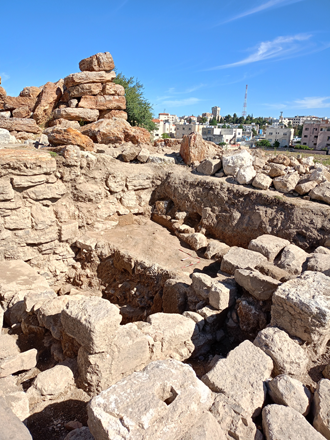AMMAN — The Polish archaeological team recently dug at Khirbet as-Sar, a site in Bayader Wadi Sir, on the western outskirts of Amman. The site has a long occupancy and was known from the Ammonites and Roman times.
"Other trenches excavated by our team were located on two opposite sides in the eastern part of the Roman-period courtyard, which is flanked by rows of arches whose architectural style points to their construction during the 2nd/3rd century AD," said Professor Emerita Jolanta Młynarczyk from the University of Warsaw.
Młynarczyk noted that the general remark is that all the Roman structures, the traces identified within the site, were extensively reused throughout all the later phases: Byzantine-Umayyad, Abbasid-Fatimid and Ayyubid-Mamluk.
Thus, two distinct levels of the Ayyubid-Mamluk period (13th-15th century) were identified in the trenches opened in the northern part of the courtyard, with built domestic installations accompanied by pottery and animal bones, she continued,
The professor added that one of the rooms, however, which, instead of ceramics, yielded remains of an iron slag and a couple of horseshoe nails, may have functioned as a blacksmith workshop.
"The level below the Ayyubid phase of architecture belonged to the Early Islamic [probably Abbasid] period and included stone installations accompanied by metal [iron] smelting evidence. An earlier Byzantine/Umayyad phase was evidenced by a room with two pillars that probably used to support an arch; two of its walls were constructed upon Roman-period walls, possibly connected with a gate that would lead to the sanctuary courtyard," Młynarczyk underlined.
On the opposite southern part of the ancient courtyard, the team excavated on both sides of one of the arches, reaching portions of the Roman walking level, which was almost entirely obliterated by later alterations.
Also here, as in the northern part of the courtyard, the remains of the Middle- and Early-Islamic periods were very distinct when new walls were added to the old Roman structure.
"The uppermost floor, dated to the 14th century AD, may have been connected with some industrial activity, as judged by the findings of stone grinding devices and fragments of heavy ceramic containers. It was preceded by an Ayyubid-period phase during which a room covered by a barrel vault was constructed," Młynarczyk underlined.
She noted that below this Middle Islamic level, parts of two rooms of an Umayyad-period habitation were found. One room of a domestic character contained a huge pithos, while the other was paved with a monochrome mosaic, a part of which was destroyed during the earthquake of 749 AD
The artefacts found during the excavations at Khirbat as-Sar were mainly numerous fragments of pottery that served as the primary tool for dating the walls and floors; besides ceramics, some fragments of glass vessels were discovered, Młynarczyk outlined, adding that a few bronze coins were found, covering the time span of the 1st to 4th century AD, but they were useless for dating because they came from secondary contexts.
"Fragments of terracotta oil lamps come from different layers, dating from the 2nd century AD to the 13th century AD. Other finds included a range of domestic tools, such as stone and metal. Worth mention is a small melting pot of bronze found in an Early Islamic context; it was used for casting small metal objects, of which a range of personal items was discovered, including bronze and iron pins, buckles, finger rings, and pendants. Many fragments of glass bracelets were found in the Middle Islamic layers," said Professor Mariusz Burdajewicz.
Due to a summit, the site's role was to serve as a watchtower.
"This kind of structure suggests a possible military/defensive character that harmonises perfectly well with the site's location on the western edge of the plateau, near the entrance to Wadi Sir.
The location ensures a considerable strategic potential of the site through constant control of access to Amman from both the west [Jordan Valley] and the south [the land of Moab] — such an interpretation of the tower in Khirbet as- Sar seems to be the most logical and convincing, but on the other hand, it can be challenged,"Burdajewicz explained.
Amman has many sites from the Bronze, Iron, Persian and Hellenistic periods that could serve for defensive purposes.
"Were they independently functioning structures [Shelters for local communities? Storehouses? Watchtowers? Cultic places?]," scholars asked.
Possibly, the towers were not military structures built and operated by the state but were constructed by local communities to protect agricultural installations from nomadic raids, Burdajewicz claimed, adding that it is also questionable who built the towers: the Ammonites, what may seem obvious, or the Assyrians during their imperial expansion to the south?
According to Polish scholars, these controversies stem from the fact that we still have too little information about them. In other words, too few such structures have been systematically, thoroughly studied, and fully published. For example, even after excavating the towers in RujumAl Malfuf North and RujumAl Malfuf South (located next to the DoA building), only brief preliminary reports have been published.
However, more is needed to comprehensively understand the phenomenon of the towers around Amman and more archaeological data is required to resolve the doubts above about these structures' date and original function, Młynarczyk stressed.
In some cases, interpreting these towers as a place of periodic refuge for the local population from nomadic attacks seems likely.
"Here, we share the opinion of François Villeneuve and Jean-Baptiste Humbert, French archaeologists, who consider such sites Kh. Sar as fortified agricultural settlements [including ordinary dwellings beside the tower] rather than elements of a chain of fortifications," Młynarczyk said, adding that an overall study of the "Ammonite towers" is urgently needed to define their function and chronology.
